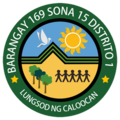History
The villages occupies parts of land historically part of Tala Estate, which was under the jurisdiction of the town of Novaliches before it was absorbed by Caloocan in 1903. [4] [5] [6] Novaliches had an area of 200 to 300 square meters (2,200 to 3,200 sq ft). Upon the creation of Quezon City in 1939, the Novaliches district was divided into two: a portion under the jurisdiction of Caloocan and Quezon City. In the Caloocan city charter of 1962, the geographical location of the current barangay which is part of Novaliches, is among portions ceded to Caloocan. [7]
In 1964, Tomas Aguirre, whose family is of the Agencia de Empeños de Aguirre pawnshop fame, founded Banco Filipino with the aid of money from the family business. By around 1966, BF had become the premiere bank in the Philippines. Aguirre, figured that with such earnings, it was time to venture into the next phase and to consider land development. With that, he put up the BF Homes Incorporated (BFHI) arm to further realize his goal.
In the barangay regrouping, Barangay BF Homes Caloocan included other real estate developments: Estrella Homes and Santa Fe Homesite.
In recent history, BF Homes is where the 2007 oath-taking of Antonio Trillanes IV as a senator occurred, wherein, as resident, his oath was administered by the barangay chairperson. Also, the suspected Communist Leader, Andrea Rosal, was arrested together with several others in a house in this barangay. [8]
Proposed merger
In 1989, Republic Act No. 6714 was enacted to reduce the number of barangays in Caloocan from 188 to 60. As part of this plan, Barangay 167 and 169 were slated to be merged to become Barangay Llano. A plebiscite was held on March 10; [9] [10] with only 10% of the city's voters participating. [11] [9] Majority of the participated voters reportedly opposed the proposal, thus the existing barangays continued as independent entities. [11]
This page is based on this
Wikipedia article Text is available under the
CC BY-SA 4.0 license; additional terms may apply.
Images, videos and audio are available under their respective licenses.


